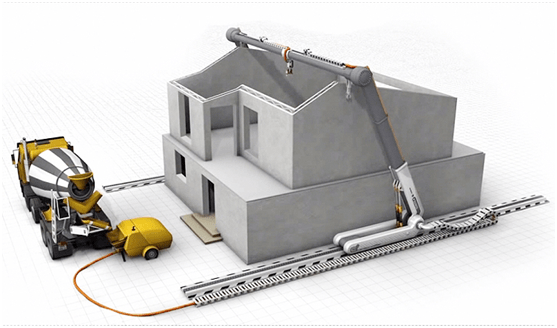Starting with the earliest small 3D printers, we tried to print a variety of things. As early as a few years ago, China also realized the printing of the basic building modules, and then successfully assembled into a small bungalow. Now, MIT has finally taken this step and realized the printing of building integration.
Researchers at MIT designed the 3D printing system, which is operated by a guided vehicle that drives a large robotic arm that prints the entire building's infrastructure. 3D printing technology can cover more and more materials, from plastics, metals to glass, and even ingredients. At present, MIT personnel try to continue this technology and use 3D printing to build the entire house structure. click
Compared to traditional building methods, this system has two advantages in speed and economy. The structure can also be customized to your needs, including printing various shapes, adapting to different terrains, and more. In addition, in the construction process, the combination of different materials can also be achieved, that is, the density, strength, insulation performance of each material in the structure can be set according to requirements. Ultimately, this technology is expected to break the limits of traditional construction methods, open the door to a new world, and help us create new conceptual buildings that were previously impossible. The system was published in the journal Science Robotics in the form of a paper by Steven Keating, with mechanical engineering graduates, former researchers at the MIT Media Lab, research assistants, and assistant professors in the media arts and sciences department.

The large mechanical arm driven by the vehicle in the system is actually operated by a small mechanical arm at one end. It has high precision and can be directly used to complete the ''jetting'' task during the construction process, such as spraying concrete within the specified range, or Surface coatings can also be fitted with other operating heads, such as a milling head. Unlike a traditional 3D printer, which has a casing that does not exceed the size of the casing, the construction system is not a closed box, but a jetting device that can move from the ground, so the size of the objects it can print is not limited. To demonstrate this feature, they built a large dome with a diameter of 50 feet and a height of 12 feet, and the entire manufacturing process took only 14 hours.
Contour Crafting, Professor of the University of Southern California, Behrokh Khoshnevis
As an initial test, they also used this system to create a foam sandwich formwork frame that could be used to build a complete concrete structure. This is similar to the template in the traditional construction method. After the formwork frame is built, it can be filled with concrete and other materials to form it, and then they are solidified and then the template is removed to complete the construction. This test is mainly to prove that the new 3D printing system can also be combined with traditional building methods and used directly under the guidance of existing building codes.
The large mechanical arm driven by the vehicle in the system is actually operated by a small mechanical arm at one end. It has high precision and can be directly used to complete the ''jetting'' task during the construction process, such as spraying concrete within the specified range, or Surface coatings can also be fitted with other operating heads, such as a milling head. Unlike a traditional 3D printer, which has a casing that does not exceed the size of the casing, the construction system is not a closed box, but a jetting device that can move from the ground, so the size of the objects it can print is not limited. To demonstrate this feature, they built a large dome with a diameter of 50 feet and a height of 12 feet, and the entire manufacturing process took only 14 hours.
Contour Crafting, Professor of the University of Southern California, Behrokh Khoshnevis
As an initial test, they also used this system to create a foam sandwich formwork frame that could be used to build a complete concrete structure. This is similar to the template in the traditional construction method. After the formwork frame is built, it can be filled with concrete and other materials to form it, and then they are solidified and then the template is removed to complete the construction. This test is mainly to prove that the new 3D printing system can also be combined with traditional building methods and used directly under the guidance of existing building codes.